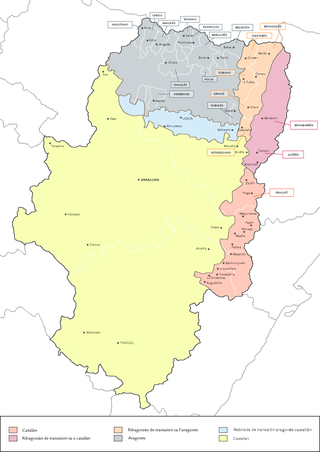
Aragonese is a Romance language spoken in several dialects by about 12,000 people as of 2011, in the Pyrenees valleys of Aragon, Spain, primarily in the comarcas of Somontano de Barbastro, Jacetania, Alto Gállego, Sobrarbe, and Ribagorza/Ribagorça. It is the only modern language which survived from medieval Navarro-Aragonese in a form distinctly different from Spanish.
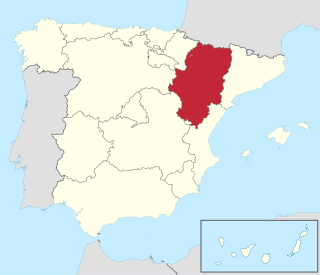
Aragon is an autonomous community in Spain, coextensive with the medieval Kingdom of Aragon. In northeastern Spain, the Aragonese autonomous community comprises three provinces : Huesca, Zaragoza, and Teruel. Its capital is Zaragoza. The current Statute of Autonomy declares Aragon a historic nationality of Spain.

Zaragoza, also known in English as Saragossa, is the capital city of the province of Zaragoza and of the autonomous community of Aragon, Spain. It lies by the Ebro river and its tributaries, the Huerva and the Gállego, roughly in the center of both Aragon and the Ebro basin.

Huesca is a city in north-eastern Spain, within the autonomous community of Aragon. It is also the capital of the Spanish province of the same name and of the comarca of Hoya de Huesca. In 2009 it had a population of 52,059, almost a quarter of the total population of the province. The city is one of the smallest provincial capitals in Spain.

The Kingdom of Aragon was a medieval and early modern kingdom on the Iberian Peninsula, corresponding to the modern-day autonomous community of Aragon, in Spain. It should not be confused with the larger Crown of Aragon, which also included other territories — the Principality of Catalonia, the Kingdom of Valencia, the Kingdom of Majorca, and other possessions that are now part of France, Italy, and Greece — that were also under the rule of the King of Aragon, but were administered separately from the Kingdom of Aragon.

The 1412 Compromise of Caspe was an act and resolution of parliamentary representatives of the constituent realms of the Crown of Aragon, meeting in Caspe, to resolve the interregnum following the death of King Martin of Aragon in 1410 without a legitimate heir.
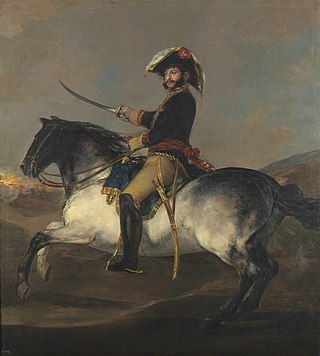
José Rebolledo de Palafox y Melzi, 1st Duke of Saragossa was a Spanish general who fought in the Peninsular War.

The Cathedral of the Savior or La Seo de Zaragoza is a Roman Catholic cathedral in Zaragoza, in Aragon, Spain. It is part of the World Heritage Site Mudéjar Architecture of Aragon.

The Aljafería Palace is a fortified medieval palace built during the second half of the 11th century in the Taifa of Zaragoza in Al-Andalus, present day Zaragoza, Aragon, Spain. It was the residence of the Banu Hud dynasty during the era of Abu Jaffar Al-Muqtadir. The palace reflects the splendor attained by the Taifa of Zaragoza at its height. It currently houses the Cortes of the autonomous community of Aragon.

Sos del Rey Católico is a historic town and municipality in the Cinco Villas comarca, province of Zaragoza, in Aragon, Spain.

Utebo is a town located in the province of Zaragoza, Aragon, Spain. At the time of the 2011 census (INE), the municipality had a population of 18,602 inhabitants, being the third most populous town of the province, only surpassed by Zaragoza and Calatayud, and one of the most populous in Aragon.

Teruel Cathedral or Catedral de Santa María de Mediavilla de Teruel is a Roman Catholic church in Teruel, Aragon, Spain. Dedicated to St. Mary, it is a notable example of Mudéjar architecture. Together with other churches in the town and in the province of Zaragoza, it has been listed as a UNESCO World Heritage Site since 1986.

The Abbey of Santa Engracia was a monastery in Zaragoza, Aragon, Spain, established to house the relics of Saint Engratia and the many martyrs of Saragossa. The date of 392 was traditionally claimed as a foundation date, which was linked with the travels of Saint Paulinus. The church was believed to have been sited on the spot of the martyrdom of Engratia.

Royal Monastery of Santa María de Sigena is a convent in Villanueva de Sigena, region of Aragon, Spain. Built between 1183 and 1208, the Romanesque church was founded by Queen Sancha of Castile, wife of Alfonso II of Aragon.
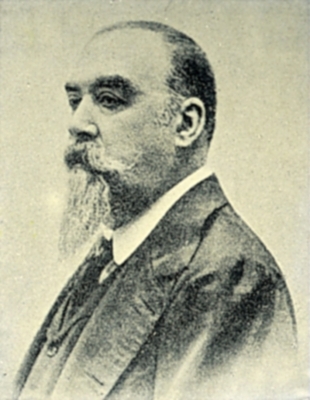
Marcelino de Unceta y López was an artist, illustrator, and painter of Zaragoza and Madrid. Unceta produced historical paintings, especially those of military history, as well as illustrating sketches and posters meant for advertising. He is known for creating in 1879 what is considered the first poster for a bullfight. His memorable drawings of horses and bulls in his posters made him a well-known artist in Spain of the time.
Stefan Lehmann is a German classical archaeologist.

Martín Bernat was a Spanish Gothic style painter, active in Zaragoza, where he had a long collaboration with Bartolomé Bermejo. His dates of birth and death are not known.

Miguel Ximénez was a Spanish Gothic painter.

Hedy Hahnloser-Bühler was a Swiss painter, craftswoman, art collector and patron of the arts.
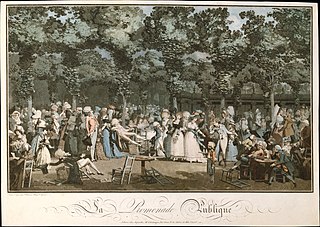
European printmaking in the 18th century grew greatly in quantity, and generally had high levels of technical skill. But original artistic printmaking declined, with reproductive prints becoming the majority. Many printmakers mixed intaglio printing techniques on the same plates with great skill. The generally reduced level of artistic creativity in printmaking changed at the end of the century with the great print series of Goya, whose career stretched into the 1820s but is all covered here. Goya is usually taken as the end of the old master print era, to which the 18th century added relatively little.



















